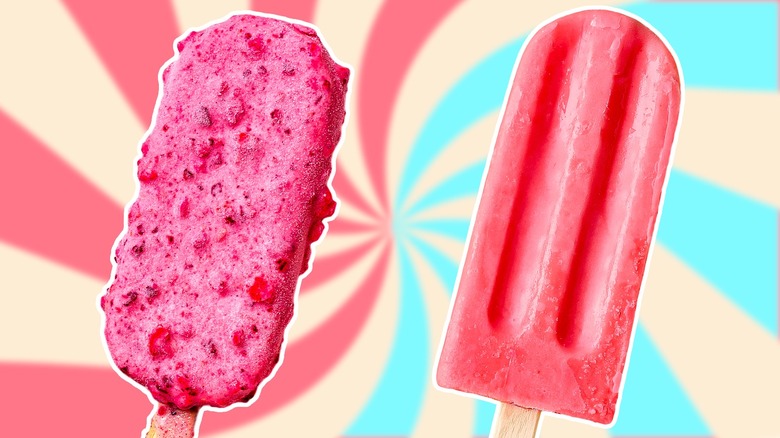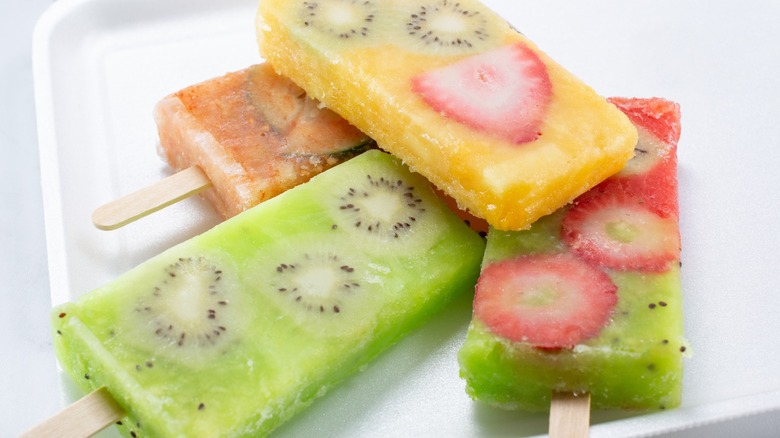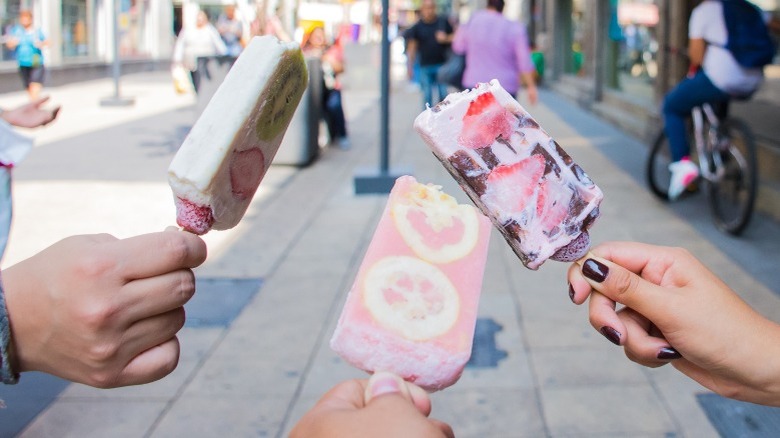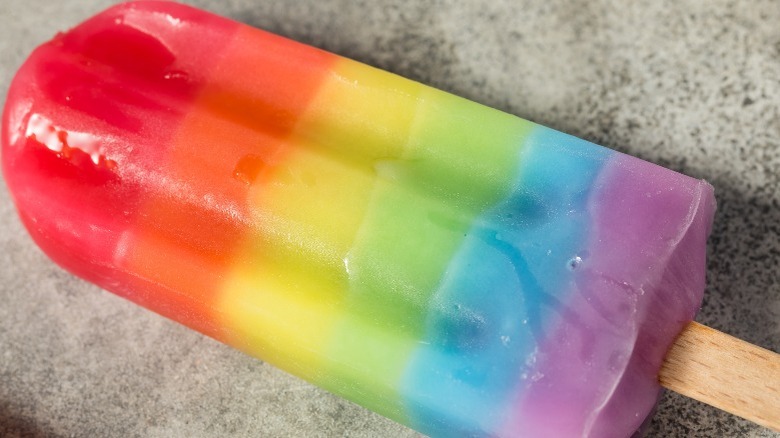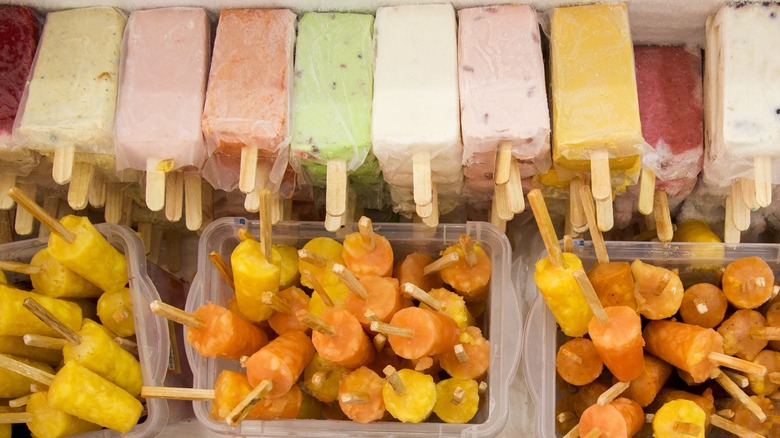Is There A Difference Between Paletas And Popsicles?
When trying to describe what a paleta is to the uninitiated, people will most often say, "Well, they're kind of like Mexican popsicles." But truthfully, there are a lot of differences between the two hot day desserts, from where and how they were conceived to what they're made of. For starters, the two icy treats have radically different origins. Paletas were invented in Mexico by enterprising adults out of necessity, whereas popsicles were created unintentionally in San Francisco by an 11-year-old.
The sweet treats reflect these vastly different origin stories in their makeup; paletas favor organic ingredients that fit into two main flavor profiles, whereas popsicles are typically made of sweet syrup and water. Because paletas favor natural ingredients over corn syrup, they often offer a bigger nutritional bang for your buck, but that's not to say there aren't 100% fruit-based popsicles out there, you just have to look a little harder for them.
What are paletas?
While there is some debate about the exact inventor of paletas, food historians agree that the flavorful treats first originated in the town of Tocumbo, Mexico, in the 1940s. Mexico was still reeling from the Great Depression, and, as was typical of Depression-era food preparation, families in Tocumbo were limited to affordable, easy-to-access ingredients. Surrounded by sugar cane fields, the underpaid farm workers in the area had access to fresh fruits and nuts — both of which would eventually make their way into the base ingredients of paletas.
Looking for a way to make a little extra income, resourceful families started mixing the natural ingredients with sugar and milk and freezing their sweet sludge overnight. The next day, they'd head out into the neighborhoods selling the frozen treats — named for the sticks frozen into them — from little carts on wheels. The sour and tangy frozen fruit was a welcome break from the sweltering heat of the sun. Eventually, the money from the popularity of these frozen desserts helped these families open up ice cream shops or "paleterías," which remain popular in Mexico to this day.
What are popsicles?
It's hard to hear the words "childhood" and "summer" and not think about brightly colored popsicle juice dripping down your forearm. Popsicles are as linked to the nostalgic days of summer as jumping through the sprinkler and water balloon fights. That's why it should come as no surprise that it was actually an 11-year-old boy who accidentally invented the popsicle. In 1905, San Franciscan Frank Epperson left a cup of soda with the sweet powder and stick used to mix soda sitting out overnight.
It was a cold Bay Area night, and when little Frank stumbled upon his forgotten soda the next day, he found it had frozen solid. Hence, the idea for the popsicle was born. Ironic, considering that the dessert that is synonymous with a hot summer day was born on a cold, presumably winter, night. From that day on, Epperson continued making and (eventually) selling what he called "Epsicles." Nineteen years later, Epperson patented Epsicles. By then, he had acquired the nickname "Pops" from his children, which helped evolve Epsicles into Popsicles. While Popsicles are technically a trademarked creation, the term "popsicle" is often used to encompass any sweet frozen treat on a stick.
Paletas feature more natural ingredients
Since their invention, Popsicles have branched out to different categories, including Creamsicles and Fudgsicles, but the original flavors still prominently feature water, glucose-fructose corn syrup, and sugar as their main ingredients. Their unnaturally bright color combinations, artificial flavorings, and food dyes scream one thing: We are marketing to kids. There are many different types and brands of store-bought popsicles these days, and some can even fall under the paleta category if they're made with mostly natural ingredients. But the authentic, original Popsicle brand is as unnatural as an elephant on a tightrope.
Paletas, however, are slightly more sophisticated when it comes to ingredients. To start, paletas are made with natural ingredients, featuring big chunks of fruit, nuts, or herbs dispersed throughout the whole treat, which gives you fun textures to chew through. Paletas also require fewer ingredients than a typical popsicle — authentic, homemade paletas can have as few as four — but the ingredients that paletas do include are often packed with flavors like lime, condensed milk, tamarind spice, or mango.
Popsicles are sweeter and more one-dimensional
As you can imagine, a difference in ingredients leads to a difference in flavor. While some paleta companies might stray from the traditional flavor profiles, paleta makers typically stay in one of two lanes: water-based or milk-based flavor profiles. Don't let the "water-based" moniker fool you, this still means that the primary flavoring agents are fruits, it's just not as creamy as the milk-based ones. Some traditional water-based paleta flavors are things like mango flavored with tamarind spice, or lemon sweetened with honey, kiwi, or strawberry. Milk-based flavors include flavors similar to dulce de leche or horchata desserts.
When it comes to flavoring popsicles, it's kind of like the wild, wild West. Because artificial flavoring is heavily relied upon, you'll find that many popsicles share similarly cloyingly sweet flavors in the cherry, orange, grape, and berry families. These flavors are often featured in fun shapes like rocket ships, crayons, and even Sponge Bob — but aside from their aesthetic appeal, they cannot compete with the fresh fruit and organic flavor combinations of paletas.
Paletas are the healthier choice
When it comes down to which sweet treat is better for you, there's no competition: The winner is paletas all the way. Popsicles have very little nutritional value and contain a lot of artificial sugars as well as flavoring agents not included in a balanced diet. Paletas, on the other hand, do not require added sugars because the chunks of fruit are sweet enough as it is. They also score low on the glycemic index, while branded Popsicles have a medium score. So, if you're trying to keep your blood sugar down, paletas are the better option.
Paletas and popsicles are two distinct desserts, with vastly different histories, but the beauty is that they both serve the same purpose: providing a delightful way to cool down on a hot day. So, if all you're craving is something tasty and cold, you can probably safely satisfy your taste buds with either a paleta or a popsicle. Hot tip: If you don't have access to freshly made authentic paletas but want a healthier alternative to what's at the grocery store, consider making your own popsicles at home.
